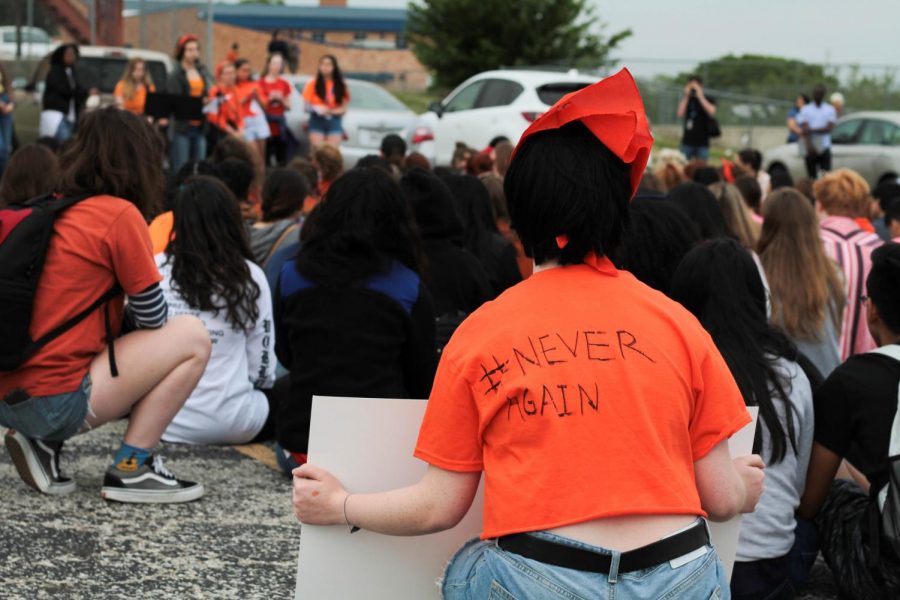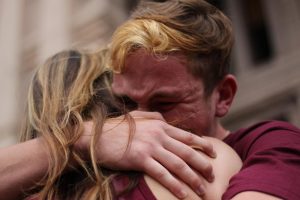The story behind the McCallum walkout
Mac’s April 20 walkout was the culmination of months of planning, coordination and teamwork. But the three Knights behind the protest say it’s just the beginning
Students listen as senior Isabel Lerman reads a list of student demands to make schools safer. Between 300 and 400 students walked out of first period at 10 a.m. to participate in a McCallum walkout, part of National Student Walkout to advocate for tighter gun control laws. Photo by Ian Clennan.
June 6, 2018
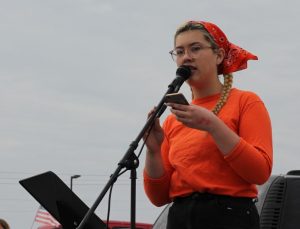
Hundreds of McCallum walked out of their classrooms at 10 a.m. on April 20 to protest gun violence and to urge the government to do more to stop it. The walkout is a well-known story, but what is lesser known is the story of the three main students who organized it.
A few days after the Parkland shooting, junior Liz Epperson saw a post on Twitter about plans for a walkout. Having participated in the inauguration walkout last year, and having stayed politically active as the president of the MAC Justice Coalition, Epperson felt as though she had to do something.
“I would describe my enthusiasm more as an anger,” Epperson said. “It seems like every day there is another shooting, and no gun reform. I am angry with the state of this government. Another aspect driving me is that it could be me, or my teacher, or my friend—I don’t want to wait for it to happen to us.”
Epperson put together a meeting for discussing the Parkland shooting, open for anyone in the school to show up and share their thoughts and fears. Although she said she had put together meetings like this for other political discussions, none of them had the turnout that this one did. After learning of that initial interest, Epperson knew that she should help McCallum stage its own walkout. She reached out to other leaders of the MAC Justice Coalition and together they helped put it all together.
Senior Nico Leuba-Jones also heard about the walkout through Twitter, and joined Epperson in her efforts to put the walkout together. They then reached out to their friend senior Isabel Lerman to help as well. Leuba-Jones had been the MAC Justice Coalition vice president and social media officer, while Lerman had been the coalition’s head of community outreach. Since all three of them had stayed politically active since the previous year’s walkout, they all had the resources and the prior experience to organize the protest.
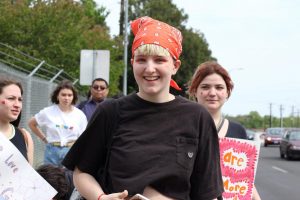
“This year was a little bit more of a noble cause,” Lerman said. “Last year was emotional and had less of a pure political stance I’d say. This year is for a cause that is important and relevant and something that we are far more likely to be able to change. I’m not trying to diss the Trump walkout. … I supported last year’s walkout, too.”
“Last year’s walkout … was something that less people could get behind because [supporting or rejecting] Trump is a highly partisan issue,” Epperson said. “This year on the other hand, was driven not only by anger but fear. It only made sense to protest at school, as we might lose our lives there if this continues. Although both were aimed at the government, this walkout had more concrete goals—we want gun safety and we want it now.”
The three of them started to host meetings during school lunch periods in order to get the word out and discuss and plan the walkout with other students in the school. During the meetings they would take notes and write out decisions. They also created a GroupMe to keep other interested students up to date. As they put plans into place, they spread the information through private social media accounts and word of mouth, in order to get activist students in the know as the three of them contacted the administration.
“Me…, Isabel, and Liz, got together and made a plan,.” Leuba-Jones said. “We hosted meetings and spread the word though social media to help get the word out. We did a lot of organizing meetings, or on Google Drive after school. Organizing took a lot of free time.”
Organizing the walkout began to take over the students’ lives. With meetings during lunches, planning after school, and even more meetings over weekends, they began to think of little else as they tried to put together a successful and thought out protest.
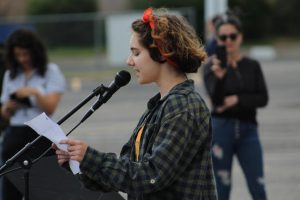
“I was thinking about it all the time, so I was always working on organizing the walkout and maintaining my grades.” Epperson said. “I started to prioritize walkout organization over schoolwork to an extent, but this walkout wasn’t all me. There were a lot of people who contributed and were just as dedicated, so that helped time management.”
All three of them had contact with some of the other schools that participated in the walkout as well. While Epperson had these contacts through previous marches and friendly relationships, Lerman and Leuba-Jones both participated in the city-wide meetings and made contact there with other student leaders from schools all over the city.
“I did have contact [with the other students] via the city wide meetings.” Lerman said. “I met people from plenty of other schools and got to see their takes on things. It was definitely a good experience and opened my mind some.”
After the walkout happened, the three of them didn’t stop keeping up with the news and reacting to it. All of them make sure to read about what’s going on and reached out to each other and other contacts they’ve made through the experience to discuss what should be done. For them, while the planning might be over, the fight is far from it.
“I am very satisfied,” Lerman said. “Things turned out far better than I expected, and it got a lot of people talking about an important movement. Now we just need to make sure people don’t forget. We should not only be concerned when a school is shot up because this issue goes so much deeper. This is a reality for a lot of people, and consciously we need to take into account how many people are affected by gun violence.”



